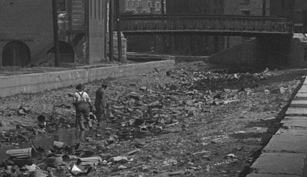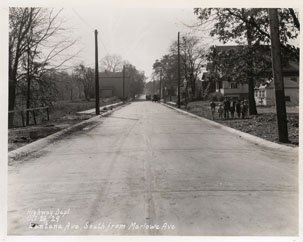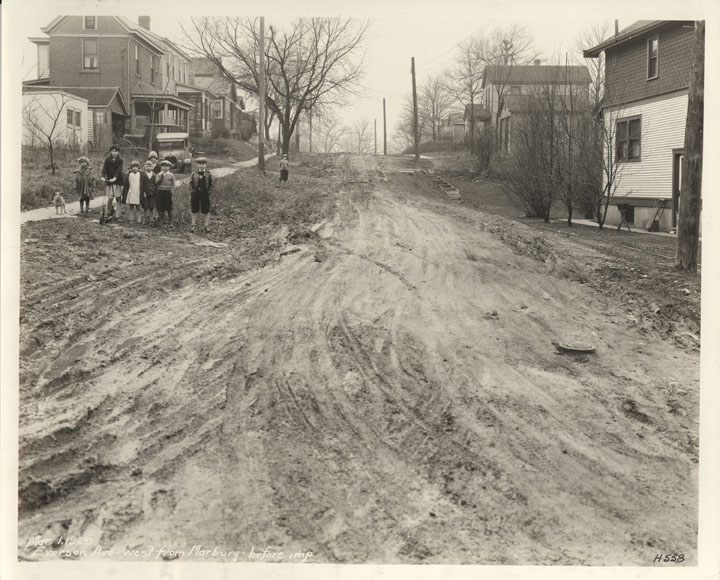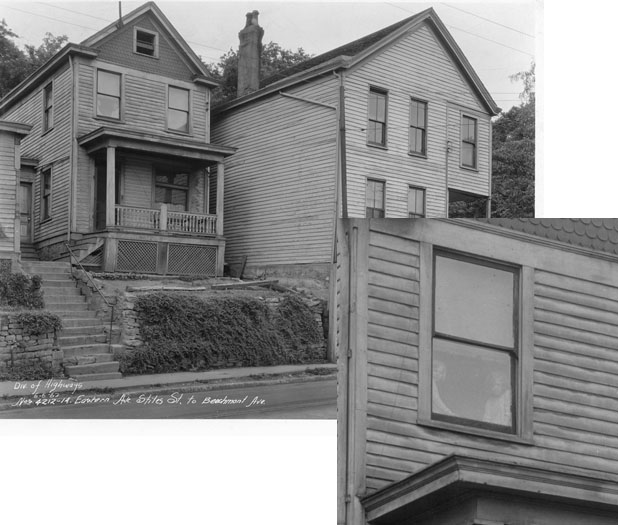By: Angela Vanderbilt
The first delivery of scans depicting the 1920s subway construction project has arrived. These scans were made from a set of highly sensitive nitrate-based negatives, which are being digitized first due to their state of deterioration. A variety of factors have contributed to this deterioration, including the physical composition (an unstable silver nitrate emulsion held on a celluloid surface), age (many are from the 1920s-1930s), and environment (negatives had been stored in a location with dramatically fluctuating temperature and humidity levels prior to being stored at UC’s ARB repository), so it’s important to have them scanned as soon as possible. For safety reasons, the nitrate negatives will be destroyed once scanning is completed and image files are approved. Following the nitrate scanning, acetate-based negatives will be scanned. These negatives are also deteriorating due to similar factors but do not pose safety issues like the nitrate negatives, apart from their offensive vinegar smell…Following the negatives, the collection of prints will be sent for scanning. When completed, we will have over 8000 digital images of the subway and street improvements projects, images portraying Cincinnati from the 1920s through the 1950s, with over half produced as positive images from negatives.
 The scans created from the first box of negatives (214 total) are proving to be very interesting, with details visible in the digitally generated scans which were difficult to pick out in the 8 x 10 negatives. For example, when reviewing a sample of scans for quality purposes, I glanced over the image of the canal bed above without noticing at first the two figures rummaging through the debris in the central right portion of the photograph (see inset).
The scans created from the first box of negatives (214 total) are proving to be very interesting, with details visible in the digitally generated scans which were difficult to pick out in the 8 x 10 negatives. For example, when reviewing a sample of scans for quality purposes, I glanced over the image of the canal bed above without noticing at first the two figures rummaging through the debris in the central right portion of the photograph (see inset).
As these images begin to emerge from the negatives, so too does the face of a city experiencing immense growth and change at the turn of the 20th century.  As I thumb through the printed photographs to prepare them for scanning, I find children and adults appearing in a window here, or on a porch there, or in a dried canal bed or grassy field. With each photograph, I’m amazed at the detail the photographer captured – the detail not just of construction sites and building damage, but the detail of everyday life from the 1920s through the 1950s. Small details like this hat lying in Bright Alley at the rear of 1024 Bank Street (Dec. 2, 1921) begin to emerge with each glance.
As I thumb through the printed photographs to prepare them for scanning, I find children and adults appearing in a window here, or on a porch there, or in a dried canal bed or grassy field. With each photograph, I’m amazed at the detail the photographer captured – the detail not just of construction sites and building damage, but the detail of everyday life from the 1920s through the 1950s. Small details like this hat lying in Bright Alley at the rear of 1024 Bank Street (Dec. 2, 1921) begin to emerge with each glance.
The photographer who created the images of Cincinnati’s subway construction and street improvement projects captured more than just the physical construction of an urban infrastructure. He captured a city that was experiencing progress and development during a period of social and economic hardship. He captured the faces of men and women passing by on the street and of children playing in yards, as well as the faces of laborers at work in the subway trenches and in communities where rutted dirt roads were being replaced with smooth concrete slabs.
Whether candid or posed, as in this image of kids who paused from play to pose for the photographer on Everson Avenue (Mar. 1, 1929), the inclusion of these individuals in the project’s official photographic record adds another layer of intrigue to our elusive photographer. Was he an artistic photographer hired for the project, and so had an eye for detail? Or was he a Rapid Transit employee assigned to photograph their progress, and simply captured what was in the frame? Some of his compositions are quite artistic, such as the hat lying in the alley.
Sometimes these intriguing details and faces are immediately evident. Other times, they require closer inspection, as in this image of a house on Eastern Avenue (June 6, 1932). At first glance, you don’t notice the two girls peeking down from the upper left window.
The before-and-after photographs of neighborhoods during the street improvement project portray another vivid image of urban development beyond the subway construction. Images of newly built homes, such as these houses below located on Lantana Avenue, lining deeply rutted dirt roads contrast dramatically with photographs of the same houses facing smoothly paved streets just a few months later.
 Much more on photographs such as these to come as the digitization of the Cincinnati subway and street improvement projects collection continues!
Much more on photographs such as these to come as the digitization of the Cincinnati subway and street improvement projects collection continues!
 This project is funded by a grant for $60,669 through the Library Services and Technology Act, administered by the State Library of Ohio.
This project is funded by a grant for $60,669 through the Library Services and Technology Act, administered by the State Library of Ohio.




